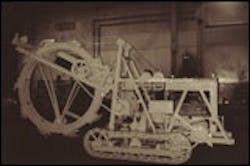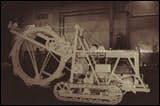Cleveland Trencher
During the 1920s, trench digging was transformed from back-aching hand labor to mechanized continuous operation by several enterprising individuals who invented and marketed specialized trenching machines. Over the next three decades, specialized trench excavators were commonplace on industrial sites, road construction, housing developments, and wherever pipes had to be laid. With the advent of the loader-backhoe in the 1950s, and the popular compact utility trenchers of today, markets for the big ditchers diminished. But for big cross-country pipeline jobs, with the right geological conditions and free of obstructions, nothing can compete with the continuous production of a ditching machine. One prominent ditcher manufacturer that has always specialized in this kind of equipment is Cleveland Trencher Co.
Back in 1921, contractor A.J. Penote Co., a water-and-sewer contractor from Cleveland, built a small wheel ditcher for a job in Detroit. Following many inquiries about this successful machine, the company decided to manufacture and sell it, and the Cleveland Trencher Co. was established in 1923. One of the first ditching machines produced was the "Baby Digger" of 1924, which helped to establish the company's reputation for tough, reliable machines.
The Cleveland Baby Digger was a wheel-type trencher with 10 buckets attached to the circumference of the wheel. All motions of the trencher were mechanically transmitted to the appropriate parts of the machine through chains and gears. The wheel was driven by a pair of spur gears meshing with teeth on the outer sides of the wheel, and the digging structure was hoisted and lowered by cables wound on worm-driven drums. The conveyor, which could be set to discharge to either side of the machine, was driven by chain from the digging wheel drive shaft. In this way, the conveyor always functioned whenever the wheel turned. The crawler tracks were driven by chains and sprockets through a differential drive with steering accomplished through wrap-around brakes on the final drive shafts. It could dig trenches from 10 to 23 inches wide to a maximum depth of 5 feet 6 inches. Power came from a Hercules 27-hp engine, and the machine's light weight of 7,400 pounds enabled it to work on soft ground and cement sidewalks without damaging them.
Over the decades, the Baby Digger's power and capacity were increased, and upgraded versions were still part of Cleveland's line well into the 1950s.
From 1968 to 1984, Cleveland Trencher was owned by American Hoist & Derrick Co. of St. Paul, Minn., and then by a management buyout team until 1986. In 1987, the company was bought by the owner of Cleveland's distributor for the Middle East and Far East, but the machines continue today to be made in the original Cleveland plant.
*You can read more about the evolution of construction equipment in Keith Haddock's book "Giant Earthmovers an Illustrated History" available in most bookstores. Also, consider a membership in the Historical Construction Equipment Association, www.hcea.net.


